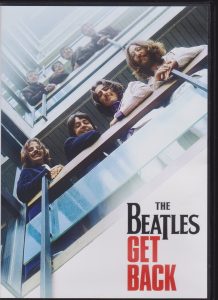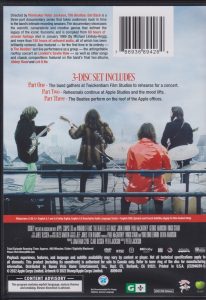(the DVD and Blu-Ray went quickly out of print)
Lots of sitting around waiting for George to return, for their Apple recording studio to take shape after they abandon the Twickenham barn, for their machinery to arrive, for John and Paul to stop goofing around between recording takes, and for their recording engineer to be ready to record. The secret recording of John and Paul’s private conversation about getting George to return is bizarre with nothing resembling common sense or productive thoughtful statements!
There are more scenes giving insights into their creative process with George Martin stuffing newspapers into a piano to make it sound more quaint and dated, with John on Hawaiian guitar on George’s “For You Blue” skiffle tune, with John on guitar playing the bass parts for “Let It Be”, and with John and Paul in rehearsal trying different accents including Dylan and Scottish on “Two of Us” run-throughs. The part where John and Paul go through the harmony syllable by syllable on the ending of the bridge is a minor study in painstaking detail.
Many songs that made it to the Abbey Road LP instead are heard here in process including “Oh, Darling”, “Mean Mr. Mustard”, and “Golden Slumbers”. A number of other song starts end up on Paul’s solo albums: including “Teddy Boy” and “Back Seat of My Car”.
Excerpts from many old rock songs including their own material continue to pop up, reflecting their early and other musical influences, the highlight of which is when John and Paul sing a chunk of The Everly Brothers’ “Bye Bye Love”.
As previously in this film, George and Ringo remain more obviously on the outside of conversations and decisions. Paul often looks to John for direction and tends to follow him for goofy outtakes; John is usually the mischief-maker keeping things light, breaking up Paul although Paul likes to ham it up whenever it’s his song.
People continue to drop in for a look-see including Peter Sellers who had worked with Ringo on The Magic Christian movie, Yoko’s art dealer, and notably pianist Billy Preston whom they immediately get on board for some rehearsals and eventual concert. A fair bit of work gradually begins to be put in on album songs such as “I’ve Got a Feeling”, “Don’t Let Me Down”, “For You Blue”, “Get Back”, and “Let It Be”.
George Martin keeps offering opinions, but has been largely sidelined throughout the film so far. In fact, EMI later gave the tapes to Phil Spector to finish up, going against John’s original intention of a bare-bones live album (those original tapes were not heard till the Naked Let It Be CD years later). Phil Spector got most of the credit for the Let It Be LP; George Martin only got a minimal, humiliating “Thanks” on the cover.
Thus, it’s understandable when at one point when Peter Jackson shows the bored and disillusioned Martin curled up on the studio floor in a vaguely ‘fetal’ position trying to pass the time reading a newspaper. (Elsewhere Martin has spoken of songs with 53 takes which frustrated him to no end when he gave advice at the time; he was often ignored though he was asked later to produce and record the group for Abbey Road ‘the old way’ afterward.)
Near the end of part 2, the original director and recording engineer confer with Paul, suggesting an Apple rooftop concert and Ringo and others go up on the roof to check things out. (There is some concern that the roof might not hold all the equipment and people on it.) So they have found a stage and only have to finish rehearsing days away from the planned show.


